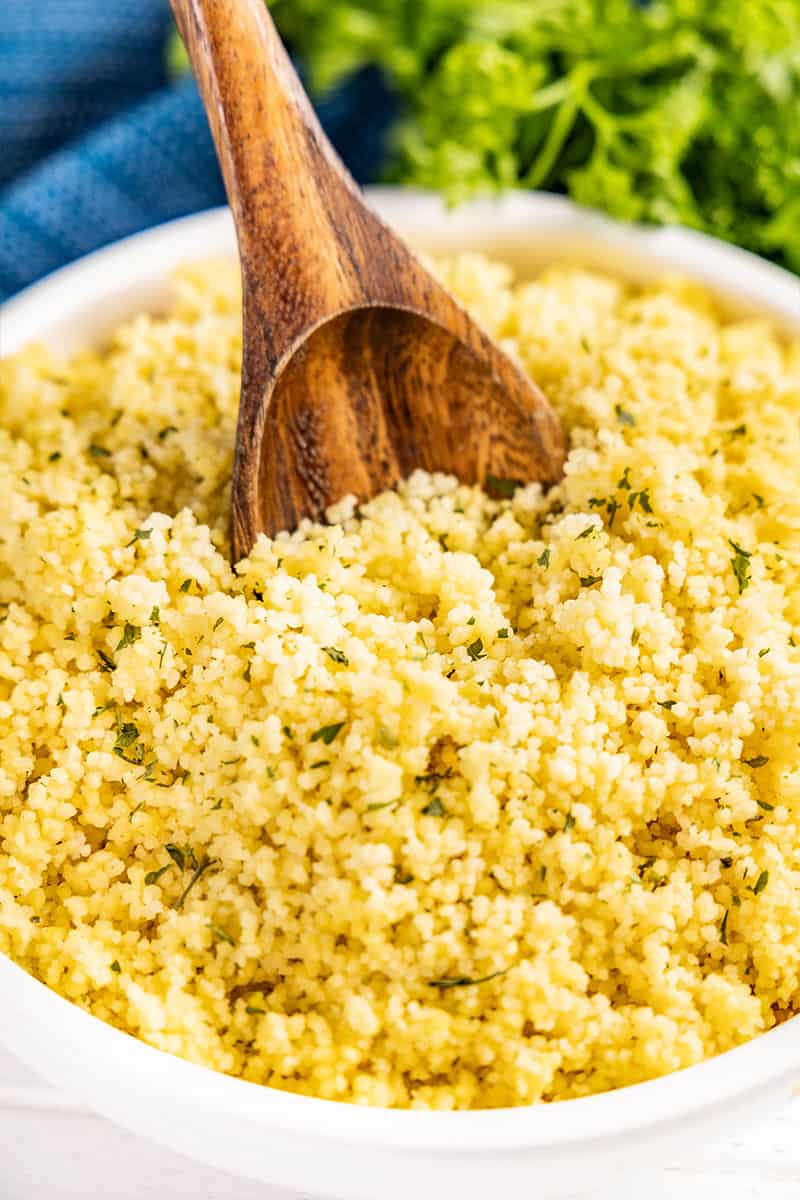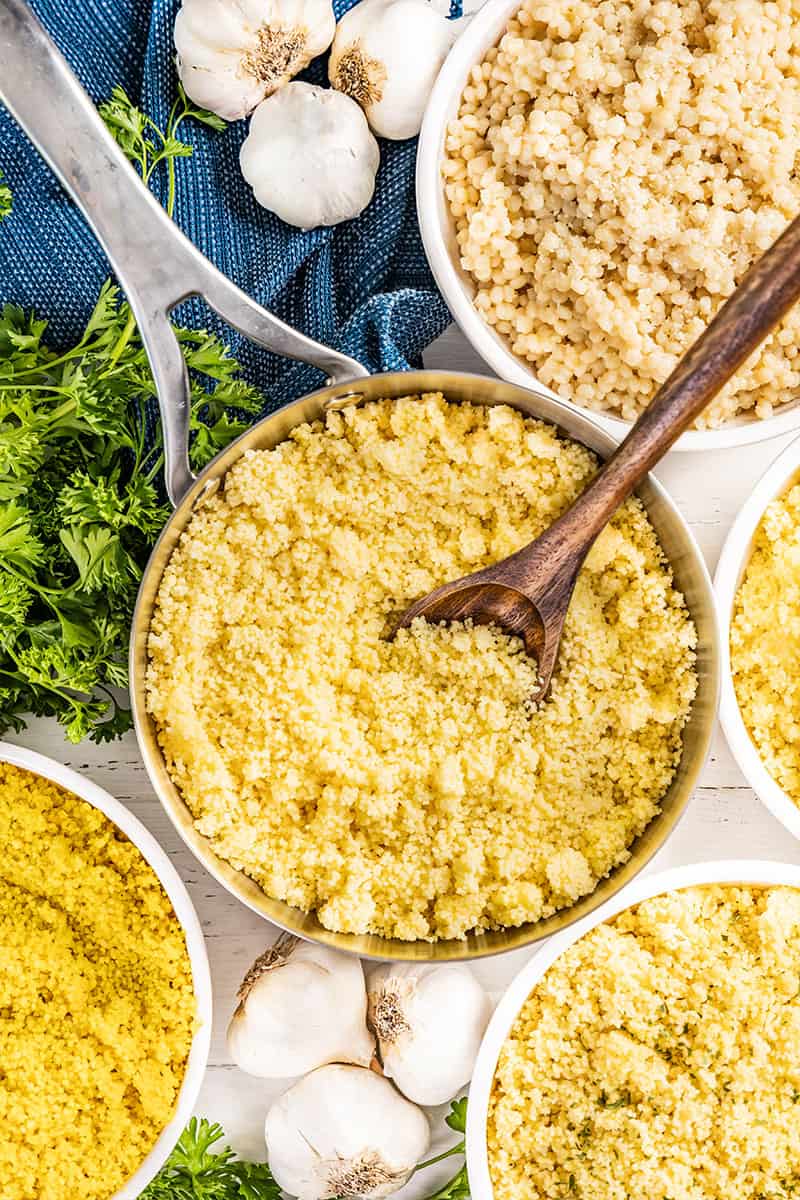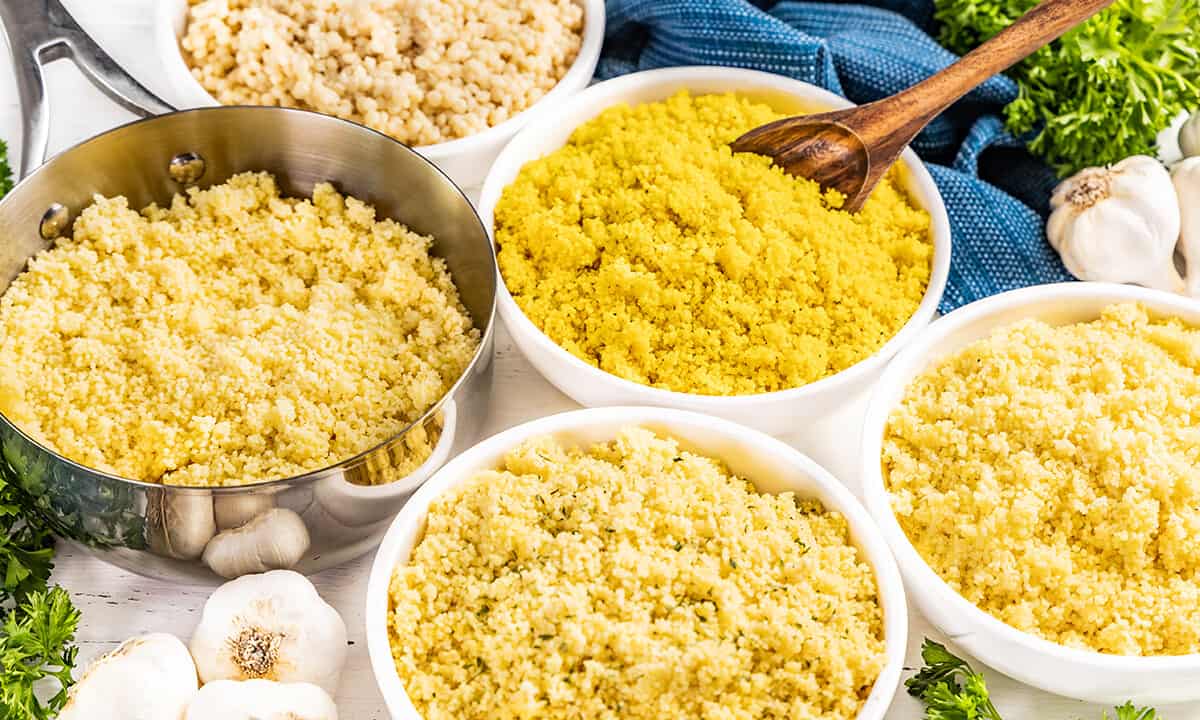Couscous is super easy to make and an excellent side dish that deserves a spot in your weekly meal rotation. We have basic instructions as well as four flavorful variations—garlic and olive oil, Parmesan, herbed chicken, and Mediterranean—so you’ll never run out of ideas. Once you learn how to make it, you’ll want to serve it up weekly – at least!
For more easy sides, try our quinoa salad or make our go-to cheesy rice.
Why Our Recipe
- Includes the basic preparation plus four more popular flavor options so you have an easy side dish that can go with any meal.
- Israeli (Pearl) couscous instructions that you can use with any of the flavors.
- Ready in under 10 minutes, with simple instructions for perfect fluffy couscous every time.

Couscous is a grain made from wheat semolina. It has been a staple in Mediterranean and North African cuisine for centuries, in countries like Morocco, Tunisia, and Algeria. It’s a fantastic alternative to rice, pasta, or quinoa. We love using it as a simple side dish or as a yummy addition to salads. It’s filling, good for you, and can be prepared in under 10 minutes. Win!
Types of Couscous
Moroccan Couscous: The most common variety, it consists of tiny grains and cooks in just minutes. It’s pre-steamed and only requires rehydration with boiling water.
Israeli (Pearl) Couscous: Larger, pearl-shaped grains that take slightly longer to cook. Its texture is more similar to pasta. You’ll simmer this type on the stovetop rather than simply combining it with boiling water.
Where to Find It: You can usually find couscous in the pasta or grain aisle at most American grocery stores. It’s often shelved alongside other quick-cooking grains like rice, quinoa, or bulgur.
Flavor Variations
Once you’ve mastered the basics, you can take your couscous to the next level with one of our delicious flavor variations, all of which are included in the printable recipe card below. Each variation adds its own unique twist, perfect for pairing with different meals or showcasing as a stand-alone dish.
Basic Couscous: The foundation of all great couscous recipes. The ultimate blank canvas! It’s light, fluffy, and neutral in flavor, making it the perfect base to pair with almost anything. Keep it simple, or use it as a starting point to explore the variations below.
Garlic and Olive Oil: Sauté freshly minced garlic in olive oil until fragrant, then proceed with the basic recipe. This variation is ideal when paired with meats or roasted garlic veggies like Brussels sprouts or carrots.
Parmesan Couscous: For the cheese lovers! Cook the couscous in chicken broth instead of water, and fluff it with freshly grated Parmesan cheese after cooking. It’s a crowd-pleaser, especially with grilled chicken or Italian-inspired dishes.
Herbed Chicken Couscous: Season your couscous with dried herbs like parsley, rosemary, thyme, and sage to complement chicken dishes. Use chicken broth for extra flavor.
Mediterranean Couscous: Add a bold blend of spices including cumin, turmeric, oregano, and a pinch of cinnamon to the cooking liquid. Perfect for serving with kabobs, lamb, or in a fresh Mediterranean salad.
Israeli Couscous Origins
Israeli couscous, also known as pearl couscous or ptitim, isn’t the same as traditional Moroccan couscous. It was created in Israel in the 1950s as a budget-friendly alternative to rice. While Moroccan couscous is tiny and more like a grain, Israeli couscous is larger and closer to pasta.
And guess what? It’s not the only pearl-shaped pasta out there! Similar versions like Italian fregola or Maftoul made using bulgur exist. The name “Israeli couscous” is just what it’s commonly called today and labeled as in the grocery store.

Serving Suggestions
Cooking couscous – no matter what kind – is simple and easy! Whether you’re serving it hot alongside your favorite entrée or using it as the base for a refreshing salad, the possibilities are endless. Here are some of our favorite ways to enjoy couscous:
With Roasted Vegetables: Pair it with roasted cauliflower, brussels sprouts, butternut squash, broccoli, or carrots
Alongside Meats: Serve couscous with steak and potatoes, beef kabobs, lamb chops, or braised lamb shank. Add a splash of chimichurri or a squeeze of lemon for added zing.
Add to Salads or Grain Bowls: Turn couscous into a light, refreshing salad. Mix in fresh ingredients like chopped cucumbers, cherry tomatoes, red onions, and drizzle with olive oil and lemon juice for a simple Mediterranean-style salad. Add couscous to dishes like Meditteranean chickpea salad, tomato avocado salad, or black bean and corn salad for an extra layer of texture.
Couscous Pasta Salad: Israeli couscous makes for an amazing pasta salad. Toss cooked and cooled couscous with diced bell peppers, olives, crumbled feta, and a tangy vinaigrette for a crowd-pleasing dish.
Storage and Reheating Instructions:
Refrigerate leftover couscous in an airtight container for up to 3 days.
Reheat in the microwave in a microwave-safe dish and cover with a damp paper towel. Heat in 30-second increments, stirring between intervals, until warmed through.
Tips for Reheating:
- Fluff the couscous with a fork before and after reheating to avoid clumping.
- Add a small drizzle of olive oil or a pat of butter to refresh the flavor, especially with flavored variations.

1 Comment